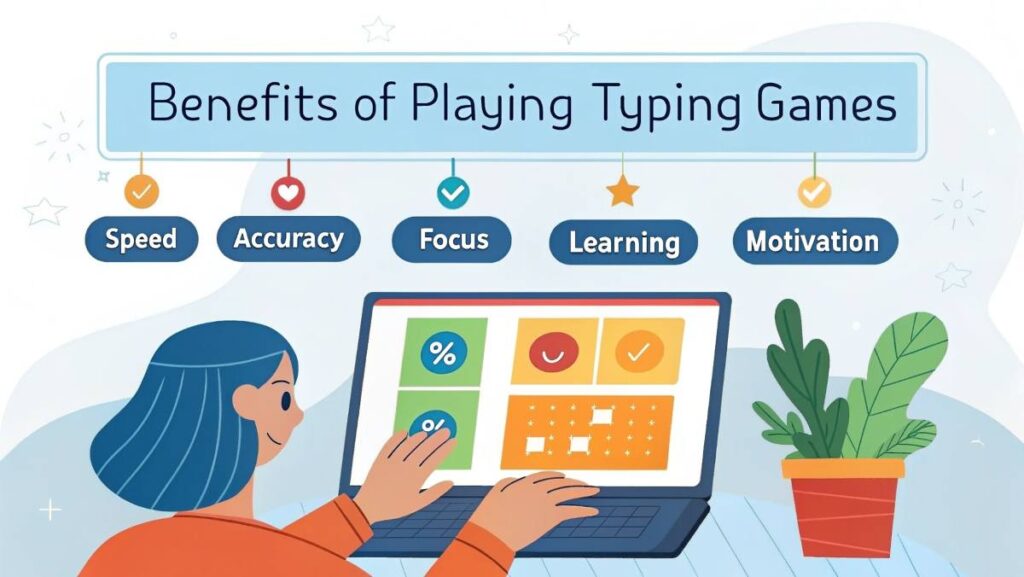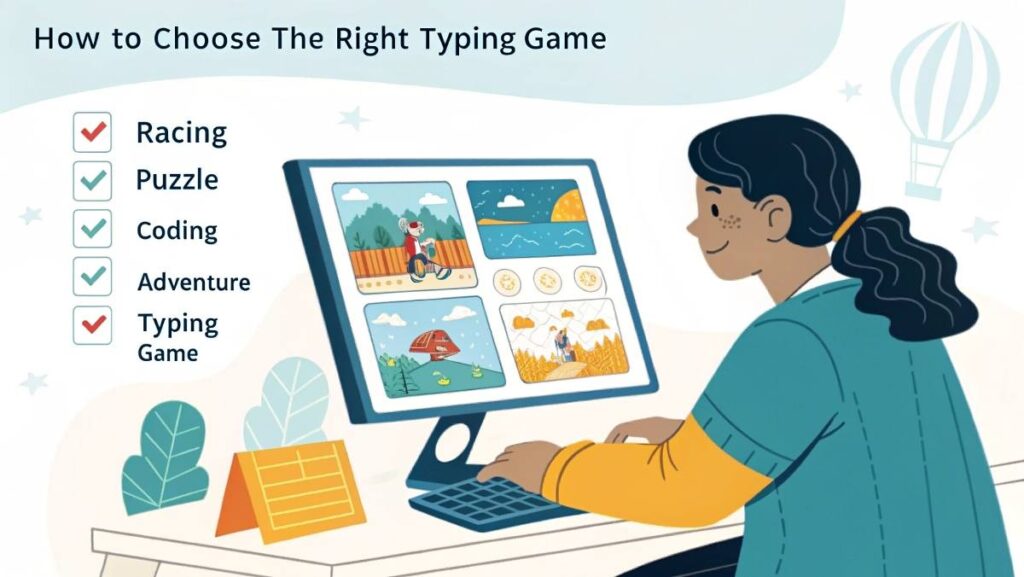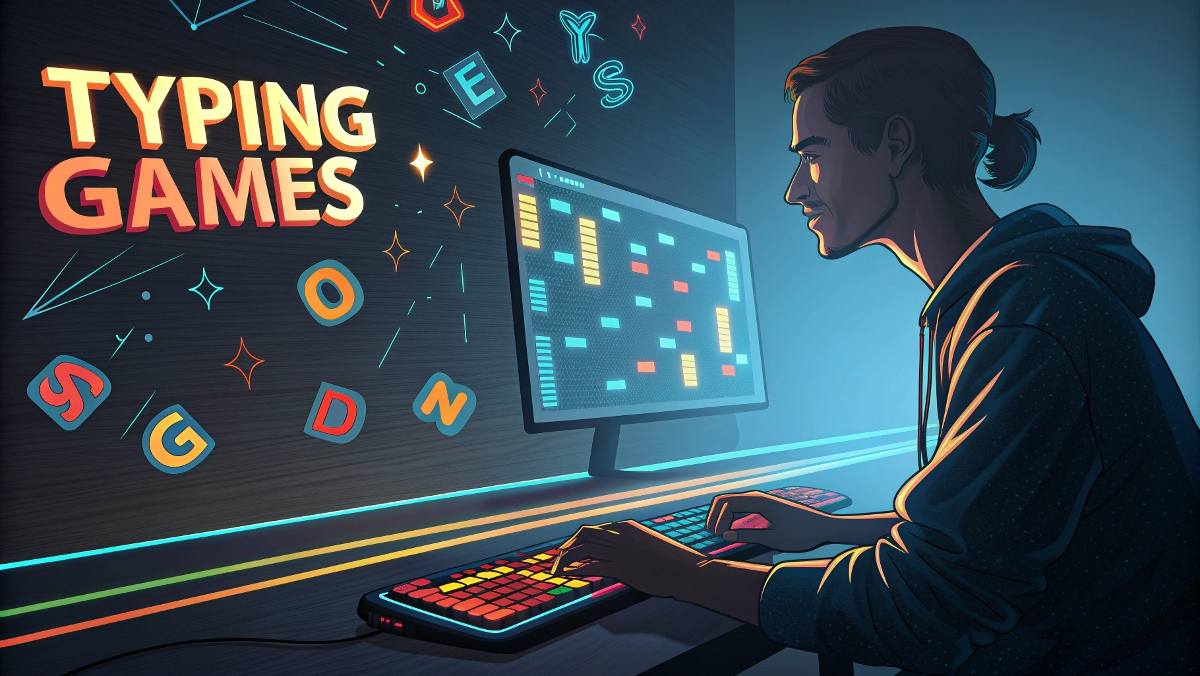We live in a world where keyboards have become extensions of our thoughts—whether we’re writing emails, chatting, coding, or blogging. But many of us still type slowly or make too many mistakes. That’s where typing games come in.
Typing games like TypeRacer, Nitro Type, Z-Type, and Typing.com make learning fun by improving typing speed, accuracy, and focus through interactive challenges. Perfect for kids and adults seeking free, educational, and entertaining keyboard practice.
If you’re tired of watching your fingers stumble over keys, this article is here to help. By the end, you’ll know which games are worth your time, how to pick one that fits your style, and reliable tips to see real improvements.
What Are Typing Games?
At its core, a typing game is any (digital) activity where you use your keyboard to complete challenges—typing words, sentences, or commands under constraints (speed, accuracy, time, etc.). What distinguishes them from plain typing drills is the game layer: scoring, levels, competition, time pressure, or narrative elements.
Over time, the genre has evolved. Early typing games were simple drills (type these letters, type these words). Now, many integrate storylines, RPG elements, puzzles, or multiplayer modes.
We can split typing games into two broad categories:
- Educational typing games: Focused on teaching or reinforcing touch-typing skills, often used in classrooms.
- Entertainment typing games: More playful, sometimes narrative-based, sometimes competitive.
Either way, the idea is the same: make typing practice more engaging.
Benefits of Playing Typing Games

Typing games aren’t just fun—they carry real, measurable benefits for your skillset. Some of these benefits have been supported by studies and observations in educational and cognitive research.
Improved Speed & Accuracy
The most obvious gain: as you practice, your words-per-minute (WPM) and accuracy improve. Typing games push you to type under pressure or with incentives, which reinforces muscle memory and helps reduce errors.
Better Cognitive and Motor Skills
Typing demands coordination between your visual system, your brain’s language processing, and your fingers. Over time, you build stronger neural pathways between these systems. Research shows that frequent typing (even not formally taught) correlates with high levels of typing ability in student populations.
Additionally, typing games can boost attention, working memory, and spatial reasoning because you have to scan words, anticipate, and react quickly.
Increased Motivation & Engagement
Traditional drills can be tedious. With games, you’re always chasing a higher score or faster time. Elements like leaderboards, competition, levels, badges, and progress tracking make you want to come back again. Gamification is powerful here.
Transfer to Real-World Tasks
Better typing means less time thinking about the mechanics and more mental space for actual content. If you type faster with fewer mistakes, writing, coding, messaging—whatever you do with a keyboard—becomes smoother.
In some recent educational research, students using keyboards during exams produced more words and often scored higher when compared to handwriting.
Types of Typing Games
Not all typing games are created equal. Here are key types you’ll encounter:
Racing & Multiplayer Typing Games
These are direct head-to-head or time-based competitions. You race to finish a text faster than others.
- TypeRacer is the classic example: you type quotes from books, movies, or songs and your car advances as you type.
- NitroType is another popular browser-based racing game with car themes.
Ideal for those who thrive on competition and pressure.
Word Drop / Puzzle Typing Games
In these games, letters or words drop or scroll, and you must type them before they reach the bottom or time runs out.
- Falling Words is a common mode in many typing sites.
- TheTypingPractice.com offers similar modes to boost both speed and accuracy.
- Wordfall is one of the top 15 typing games in August 2025, where words “fall” and you type valid words before they pile up.
These are good for building reaction speed and vocabulary.
Coding / Developer Typing Games

These games help programmers practice typing code syntax and structures.
- Typing.io is one such example (not ranked here, but widely known in dev circles).
- CodeType is another concept where you type actual code snippets under time constraints.
Great for developers who want to type clean, fast, and error-free.
Adventure / Narrative Typing Games
Here, typing serves as input to navigate worlds, battle, or drive a story.
- Epistory – Typing Chronicles is a well-known narrative-driven typing game where your typing affects the game world.
- Its spiritual sequel, Nanotale – Typing Chronicles, also uses typing in a fantasy setting.
- More recently, indie games such as Dead Letter Dept. (2025) use typing as the core mechanic in a darker, narrative setting.
- Cryptmaster is another example: you type commands to explore crypts, fight enemies, or solve puzzles.
These offer more immersive experiences for players who want more than just speed training.
Best Typing Games to Play in 2025
Here’s a curated list of standout typing games as of mid-2025. Each brings something unique.
| Game | Platform(s) | Highlights | Best For |
| TypeRacer | Web / Browser | Real-time race against others; quotes from books, music, movies. | Competitive learners |
| Typing.com’s Games | Web | Free, varied modes (balloon pop, spaceship, zombies) | Beginners, students |
| TheTypingPractice.com | Web | Multiple interactive modes, feedback on speed & accuracy | Casual learners |
| Epistory – Typing Chronicles | PC / Steam | Narrative world tied to typing mechanics | Gamers who want immersion |
| Nanotale – Typing Chronicles | PC / Steam | Fantasy/RPG elements with typing mechanics | Story lovers + typists |
| Dead Letter Dept. | PC / Steam | Typing as central gameplay in a suspenseful setting | Mature audience, narrative fans |
| Cryptmaster | PC / Steam | Type commands to solve puzzles & fight in a roguelike style | Strategy + typing fans |
| Wordfall | Web | Words drop, you type valid words to clear space | Fast typers with vocab skills |
You’ll find other options on browser game portals like Poki, which offers dozens of free typing games across devices.
Also, older classics like Z-Type (a “shoot ’em up” style where you eliminate enemies by typing) still have replay value.
How to Choose the Right Typing Game

With so many options, picking the right one is key. Here are criteria you should consider:
- Your goal: If you want to maximize speed, racing or drop-word modes are best. For immersion, narrative games are ideal.
- Skill level: Beginners may want something forgiving; advanced users can take on harder game modes.
- Feedback & analytics: Choose games that offer reports, error breakdowns, WPM histories, etc. This helps you track progress.
- Platform & accessibility: Browser-based is easiest (no installation). Steam/PC games may offer deeper experiences but need setup.
- Replay value & updates: Games with new content or challenges keep things fresh.
- Theme & appeal: If you like fantasy worlds, go for narrative typing games. If you like competition, pick racing ones.
Tips to Get Better at Typing Using Games
Playing is just the start. To see real improvement, pair strategy with consistency.
- Short, regular sessions
Aim for 10–20 minutes daily rather than long but irregular bouts. - Focus on accuracy first
Speed will come naturally if you don’t reinforce mistakes. - Mix game types
Alternate between racing, puzzle, narrative, and code typing to stimulate different skills. - Set incremental goals
Try to bump up WPM by 2–5 points every week or reduce your error rate by 1–2%. - Review mistakes
If the game shows your frequent misspelled words or key errors, focus drills there. - Use proper posture & ergonomics
Good posture, correct finger placement, and a comfortable keyboard help avoid strain. - Combine with non-game typing drills
Use blank text practice, structured lesson plans, or transcripts after playing. - Track progress
Keep a spreadsheet or journal of your WPM, accuracy, and game results over time. Seeing growth is motivating.
Future of Typing Games (2025 & Beyond)
Typing games are not standing still. The future holds interesting innovations that may change how we practice.
- AI-adaptive difficulty
Games may dynamically adjust difficulty based on your performance, pushing you just enough to improve. - AR / VR typing environments
Researchers are exploring virtual hand representation and how typing behaves in immersive spaces. One study showed that rendering virtual hands increased typing performance and usability significantly. - Gesture / EMG input
New interfaces (like EMG sensors) might let you type using muscle signals or subtle gestures—no physical keyboard needed. - Typing as game mechanics in broader games
More games are using typing as core input—Dead Letter Dept. and Cryptmaster are recent examples.
Also, a new roguelike deckbuilding typing game “TypInc.” is emerging, combining typing with card mechanics.
These developments point toward a future where typing training and entertainment merge more seamlessly than ever.
FAQs
Are typing games effective for learning touch typing?
Yes—when played consistently and with attention to accuracy, typing games reinforce muscle memory, reduce hesitation, and improve speed.
What’s a good typing speed (WPM)?
For most people, 60–80 WPM is solid. Many jobs expect 80+ for transcription. Advanced typists often reach 100+ WPM.
Can children benefit from typing games?
Definitely. The game format keeps them engaged, and many free platforms are kid-friendly. Just ensure the difficulty is right for their level.
Are free typing games worth it, or should I pay for premium ones?
Free games can be excellent for foundational practice. Paid or premium games often offer more polish, analytics, story content, or advanced challenge modes.
How long before I see improvement?
With daily practice, you might see measurable gains (3–10 WPM) in two to four weeks. Don’t expect massive leaps overnight.
Conclusion
Typing games have transformed the way people learn and practice typing. What used to be repetitive drills has evolved into engaging, skill-building entertainment suitable for all ages. Whether you’re racing opponents on TypeRacer, exploring fantasy worlds in Epistory, or mastering code in Typing.io, these games make learning both productive and fun.
By dedicating just a few minutes a day, you can dramatically boost your typing speed, accuracy, and confidence. The best part? You’ll enjoy the process. So, pick a game that suits your style, stay consistent, and watch your fingers glide effortlessly across the keyboard — turning practice into play.
